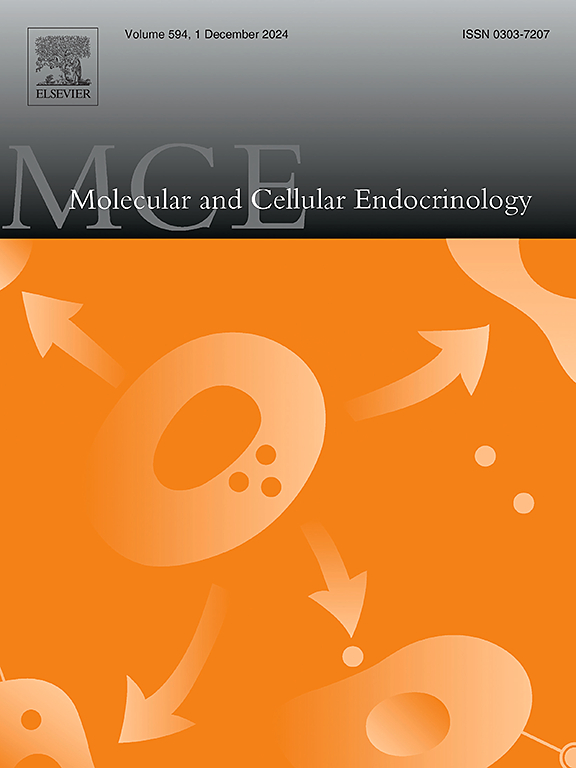Sarcospan是脂肪分布的一个候选基因,可能影响脂肪细胞中的脂质储存。
IF 3.6
3区 医学
Q2 CELL BIOLOGY
引用次数: 0
摘要
背景和目的:Sarcospan (SSPN)基因的遗传和表观遗传变异与人体脂肪分布参数(体重指数、腰臀比)、葡萄糖稳态和脂肪细胞大小有关,可能通过影响脂肪形成。本研究旨在阐明SSPN对脂肪形成的影响,特别关注其启动子甲基化。材料和方法:用编码DNMT3a、CRISPR/dCas9-Suntag的荧光标记质粒和携带转录起始位点区域互补的引导rna的载体转染永生化小鼠附睾前脂肪细胞,分化为成熟脂肪细胞。我们在附睾前脂肪细胞中进行了sirna介导的Sspn敲低,使用焦磷酸测序测量了目标DNA甲基化,并通过qPCR量化了Sspn和脂肪生成基因的转录变化。此外,我们将来自大型人类脂肪组织生物库(Leipzig Obesity biobank)的SSPN mRNA值与临床特征相关联。结果:前脂肪细胞中Sspn调控区域的表观遗传编辑导致脂肪细胞分化过程中DNA启动子甲基化显著增加(高达35%),但对Sspn表达和脂肪储存的影响很小。虽然siRNA敲低也不能帮助理解Sspn在二维脂肪形成模型中的作用,但大规模相关分析仍然表明该基因在脂肪分布和葡萄糖稳态中起关键作用。结论:尽管Sspn的表观遗传下调对脂肪形成的影响微乎其微,但人类脂肪组织中Sspn表达与脂肪分布和葡萄糖稳态参数的关联使其成为进一步研究脂肪组织代谢过程的有希望的候选物。本文章由计算机程序翻译,如有差异,请以英文原文为准。
Sarcospan, a candidate gene of fat distribution, may affect lipid storage in adipocytes
Background and aims
Genetic and epigenetic variations in the Sarcospan (SSPN) gene are associated with parameters of fat distribution (body mass index, waist-to-hip ratio), glucose homeostasis and adipocyte size in human potentially by affecting adipogenesis. This study aims at clarifying the impact of SSPN on adipogenesis, particularly focusing on its promoter methylation.
Materials and methods
Immortalized murine epididymal preadipocytes were transfected with fluorescence-marked plasmids coding for DNMT3a, CRISPR/dCas9-Suntag and vectors carrying guide RNAs complementary to the transcription start site region and differentiated to mature adipocytes. We performed siRNA-mediated Sspn knockdown in epididymal preadipocytes, measured target DNA methylation using pyrosequencing and quantified transcriptional changes of Sspn and adipogenic genes by qPCR. Additionally, we correlated SSPN mRNA values and clinical characteristics from a large human adipose tissue biobank (Leipzig Obesity Biobank).
Results
Epigenetic editing of the Sspn regulatory region in preadipocytes resulted in a significant increase (up to 35 %) in DNA promoter methylation throughout adipocyte differentiation but showed only minor effects on Sspn expression and fat storage. Though siRNA knockdown could also not contribute to understand the role of Sspn in a 2D adipogenesis model, large-scale correlation analyses still indicate the gene to be a key player in fat distribution and glucose homeostasis.
Conclusions
Although the epigenetic downregulation of Sspn showed only marginal effects on adipogenesis, associations of SSPN expression in human adipose tissue with parameters of fat distribution and glucose homeostasis make it a promising candidate for further studies addressing metabolic processes in adipose tissue.
求助全文
通过发布文献求助,成功后即可免费获取论文全文。
去求助
来源期刊

Molecular and Cellular Endocrinology
医学-内分泌学与代谢
CiteScore
9.00
自引率
2.40%
发文量
174
审稿时长
42 days
期刊介绍:
Molecular and Cellular Endocrinology was established in 1974 to meet the demand for integrated publication on all aspects related to the genetic and biochemical effects, synthesis and secretions of extracellular signals (hormones, neurotransmitters, etc.) and to the understanding of cellular regulatory mechanisms involved in hormonal control.
 求助内容:
求助内容: 应助结果提醒方式:
应助结果提醒方式:


